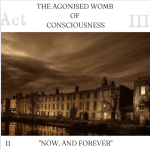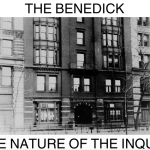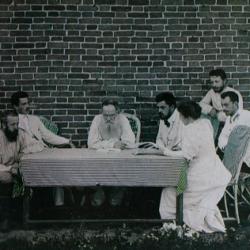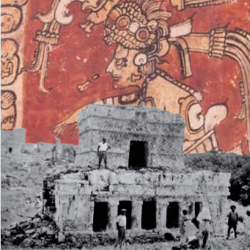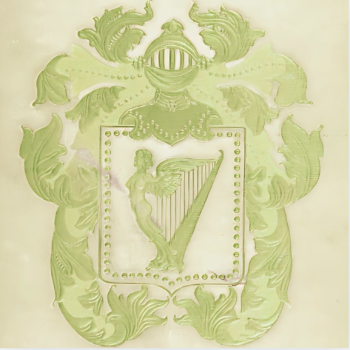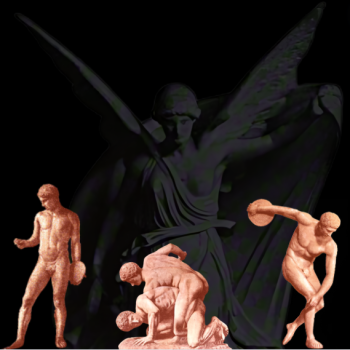PREFACE
During the academic year of 1906-1907, Henry Bedinger Mitchell, president of the New York Branch (NYB) of the Griscom Theosophical Society (GTS,) hosted a series of monthly meetings in his rooms at The Benedick Apartments (80 Washington Square East, New York) to discuss the intersection of science, philosophy, and religion. Being an adjunct professor of mathematics at Columbia University, the participants of these talks were largely pooled from Mitchell’s colleagues in the various departments of Columbia. These talks were recorded by a stenographer, and subsequently reprinted in the journal, The Theosophical Quarterly. In 1908 these articles were collected and published as a nine-chapter book titled, Talks on Religion.
In the original editions of the work the names of the participants remained anonymous, as Mitchell explains in the preface of the work:
Last winter it was my good fortune to take part in a series of meetings whose personnel and aims were alike noteworthy. The company, drawn partly from among the professors of a great university, partly from the business, literary, and ecclesiastic life of the city at large, represented many widely varying types of character and mental outlook. Not a few bore international reputations and nearly all had attained distinction in their own fields; all had known the discipline of exact thinking. It is therefore the more significant that the purpose of these meetings was the re-examination of the fundamentals of religion. The following pages are a record of this collective inquiry.
This book thus differs from many others cast in the same literary form. It is not the work or thought of one man. It is a faithful transcript of actual conversations between men whose names are withheld but whose occupations are given. No argument has been advanced for the purpose of refutation. Every opinion put forward was honestly advocated. It is true that I have had to rely upon my own memory, and have been often keenly conscious of my failure to reproduce adequately the style and manner of the participants. But it is believed that no substantial injustice has been done the views themselves.
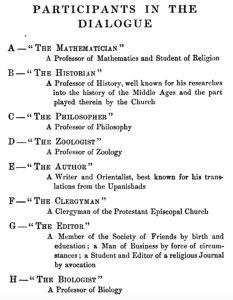
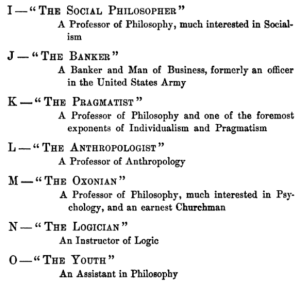
“Participants in the Dialogue.”
The formatting of Talks was also that of a script:
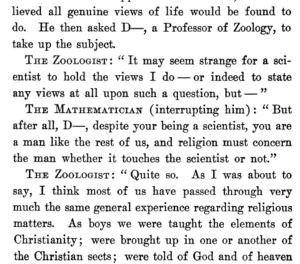
Talks on Religion format.
The following series, The Benedick, is an updated version of Talks on Religion, reformatted for easier reading, and with the inclusion of the participant’s names. I have also included three additional chapters to add more context to the original work. William James’ Columbia lecture on Pragmatism and Religion, the proceedings of the 1907 Theosophical Convention, “The Theosophical Movement,” and “Silence,” an address by Mitchell at Columbia’s then new St. Paul’s Chapel.
CHAPTERS.
Exordium: Conscientious Clergyman.
Chapter I. The Nature of the Inquiry.
Chapter II. Christianity and Nature.
Chapter III. Evolution And Ethics.
Chapter IV. Power, Worth, and Reality.
Chapter V. Pragmatism and Religion.
Chapter VI. Mysticism and Faith.
Chapter VII. The Historian’s View.
Chapter VIII.Organization and Religion.
Chapter IX. The Theosophical Movement.
Chapter X. Signs of the Times.
Chapter XI. Has the Church Failed?
Chapter XII. Silence.
PARTICIPANTS.
THE MATHEMATICIAN.
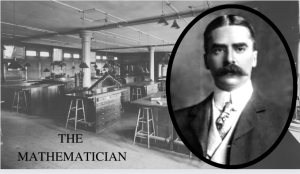
Henry Bedinger Mitchell. (1874-1956.)
Henry Bedinger Mitchell was born in Babylon, New York, in 1874, to John F.B. Mitchell, and Minnie Mitchell (pseud. Maria Blunt,) an author who wrote a first-hand account of the battle at Harper’s Ferry, West Virginia. He received his early education at John S. White’s Berkeley School at 252 Madison Avenue. He entered Columbia College in the class of 1895, where he developed a reputation for his proclivity for math, a study of which he devoted most of his attention. Outside of his studies, his principal interests were the Chess Club, and cultivating his developing interest in the Theosophical Society, which he discovered through his contact with Clement and Genevieve Griscom, his neighbors in Flushing, Queens.
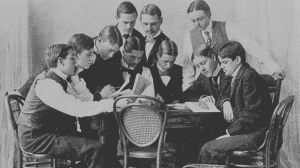
Mitchell, seated center left, with co-editors of The Columbian, 1897.
Just before the end of his first year at Columbia, Mitchell transferred to the Dresden Polytechnical School in Germany. Mitchell returned to Columbia the following year, and entered the Columbia School of Mines, where he remained for two years. He again withdrew, this time for “mercantile pursuits.” Mitchell, once again, returned to Columbia, and in June, 1898, he received the degree of E.E. (Electrical Engineering.) Mitchell remained at Columbia where he ultimately received a degree of Master of Arts in Mathematics in 1900. His thesis, titled “Transcendental Numbers: Their Existence, and Certain of their Properties, with an Introductory Chapter on Certain Theorems Regarding Infinite Assemblages,” being a combination of his mystical and mathematical interest. That same year he began teaching at Columbia as a tutor in the Faculty of Mathematics.
By 1903 Mitchell was President of the New York Branch of the Theosophical Society and living at the “Benedick” at 80 Washington Square East. A “Bachelor Apartment” so named in honor of the bachelor in Shakespeare’s Much Ado About Nothing. The apartments were especially popular with writers, architects, and brokers, who made up most of the tenants. Being mentioned in Edith Wharton’s The House Of Mirth (1905,) and also the setting for a popular story in Robert W. Chambers’ The King In Yellow (1895,) the building had a certain romantic mystique.
In 1905 Mitchell became an adjunct professor. His first year, acting under the direction of Nicholas Murray Butler, Mitchell had the unenviable task of overseeing the committee which (briefly) abolished football at the university. His popularity with students, however, remained untarnished. His relationships with his colleagues at Columbia were likewise warm, having friends across many departments.
In addition to being President of the New York Branch, Mitchell would publish a brief history of the Theosophical Society, and several articles in The Theosophical Forum, and its successor, The Theosophical Quarterly. One of these contributions, an essay titled “Meditation,” was a treatise on the use of the Theosophical method of meditation as a means of interfacing with the divine aspects of oneself (understood in this cosmology to be a Neoplatonic reflection of the universal godhead, or “Oversoul.”) In 1906 Meditation was published as a monograph, and had the distinction of being one of the first such works on the topic published in the West. By the summer of that year, Mitchell would begin preparations for a serialized set of articles for the Quarterly, called “Talks on Religion.” The series would be a candid discussion regarding the religious landscape of the time, as seen, and interpreted through, the lens of his colleagues at Columbia University. The genesis of TOR has its origin with a discussion he had with historian, James Harvey Robinson, on the separation of church and state.(These were pressing issues in France and England in the summer of 1906.) The transcription of the nine meetings held at the “Benedick,” spanning from October 1906 until July 1907, were recorded by a stenographer, and reproduced, serially, in the pages of the Theosophical Quarterly. In their original publication, the names were kept anonymous.
THE HISTORIAN.
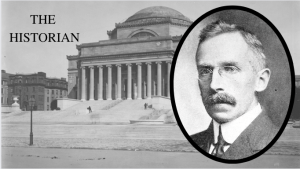
James Harvey Robinson. (1863-1936.)
Assistant professor in European history at the University of Pennsylvania, 1891-1895; professor of history at Columbia University, 1895-1919; acting dean of Barnard College, 1900; Co-founder and first Director of the New School for Social Research, 1919.
Robinson was one of the leading American historians of the twentieth century, and his 1903 work, History of Western Europe, was regarded as “little short of a revelation in historical method when it was published.” Between 1907 and 1917, Robinson would produce several books, lectures, and articles, designed to push Americans toward a progressive perspective of history. Robinson published one of his most influential works, The New History, in 1912 where Robinson asks scholars to “address their work to general audiences and history teachers to select those aspects of the past that had significance on the present.” He resigned from Columbia in 1919 in response to disputes over academic freedom, and went on to become first director of The New School for Social Research.
THE PHILOSOPHER.
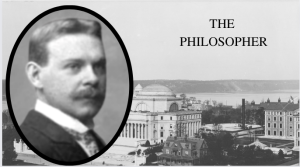
Frederick James Eugene Woodbridge. (1867-1940.)
Professor at the University of Michigan, 1894-1902; Johnsonian Professor of Philosophy at Columbia University, 1902-1937; President of the Western Philosophical Association, 1903- 1904; co-founder of The Journal of Philosophy, Psychology, and Scientific Methods, 1904; President of American Philosophical Association, 1911-1912; Dean of the Faculties of Political Science, Philosophy, and Pure Science at Columbia University, 1912-1929.
Woodbridge had a history with Mitchell and the GTS at least three years before the Talks. In 1903, a year after accepting the faculty position at Columbia, and a year before launching The Journal of Philosophy, Psychology, and Scientific Methods, which he co-founded with J. McKeen Cattell, Woodbridge delivered a lecture titled “Appeal of Idealism,” before the Griscom T.S.
THE ZOOLOGIST.
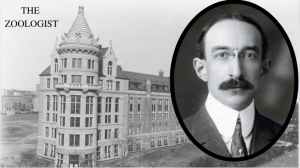
Henry Edward Crampton (1875-1956.)
Assistant in biology at Columbia University, 1893-1895. Instructor of biology at the Massachusetts Institute of Technology, 1895-1896; lecturer at Columbia University, 1896-1897; curator of invertebrate zoology at the American Museum of Natural History, 1909; faculty member at Barnard College, 1899; professor of zoology at Barnard College and Columbia University, 1904-1943; Acting provost at Barnard in 1918-1919.
In 1906 Crampton was just beginning his major series of studies on the “variation, geographical distribution, and evolution of the Polynesian land snails of genus Partula.” In the spring of 1907 Crampton embarked on an expedition to Tahiti, and surrounding islands, to conduct a momentous study which cataloged the prodigious variations in species he witnessed. The result of Crampton’s labors was the work, Studies on the Variation, Distribution and Evolution of the Genus Partula, which evolutionary biologist, Stephen Jay Gould, considered “among the most important in the history of evolutionary biology.” During the time in which Talks occurred, Crampton was delivering the Hewitt Lectures of Columbia University at Cooper Union.
THE AUTHOR.
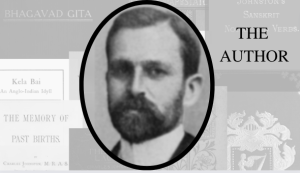
Charles Johnston (1867-1931.)
Bengal Civil Service, 1886-1892; Instructor of Sanskrit, 1892; journalist, 1891-1931; lecturer of history, Columbia University, 1905- 1908; Special Lecturer in Political Science at the University of Wisconsin, 1908; military intelligence, 1916-1919; instructor at the Russian Seminary (Tenafly, New Jersey,) 1917; Chairman of the Executive Committee of the (Griscom) Theosophical Society until his death in 1931.
While studying at Dublin’s Erasmus Smith High School in the 1880s, Johnston first met his lifelong friend, William Butler Yeats. Together the two would establish the Dublin Hermetic Society, and later, the Dublin Theosophical Society. After studying Sanskrit with Robert Atkinson at Trinity College, Dublin, Johnston was admitted into the Bengal Civil Service in 1886. From 1888 until 1890, Johnston was stationed in Murshidabad, in West Bengal. He returned to England after contracting malaria. Back in England, Johnston would write a celebrated Sanskrit grammar and complete his first major work, From the Upanishads (1896.) In 1896, at the urging of Griscom, Johnston moved to New York, where he taught one of the first non-University affiliated Sanskrit courses in the United States.
In addition to contributing numerous articles and essays to Theosophical journals, Johnston wrote for popular magazines like The Atlantic, Harper’s Weekly, Cosmopolitan, using mainstream media to subtly influence public perception of theosophical ideas. In 1899, it was said that: “Johnston [was] doing very good Theosophical work through his articles in the secular magazines. There [was] no better way to reach the public and impregnate the thought of the day with […] Theosophical philosophy, than to furnish reading which [was] not labeled theosophy.” To that end, Johnston wrote a series of four essays about meditation and reincarnation for The Metaphysical Magazine, which were subsequently published as a book under the title The Memory of Past Births (1899.) Largely void of overt Theosophical terminology, this work was one of the first books, if not the first, to introduce the terminology “past-life memory,” into the popular lexicon. Johnston would write several popular works, including Kela Bai (1900,) and several works about Ireland, including: Ireland, Historic and Picturesque (1901,) Ireland’s Story (1905,) and Ireland Through The Stereoscope (1907.) As the first President of The Irish Literary Society of New York, Johnston was a driving force behind the Irish Literary Revival and did much to publicize W.B. Yeats in the United States. (“Personal Impressions Of W.B. Yeats,” “Yeats In The Making,” “The Poems Of W. B. Yeats.”) In 1905 Johnston joined the faculty at Columbia, as a lecturer of history for the Extension Courses.
THE CLERGYMAN.
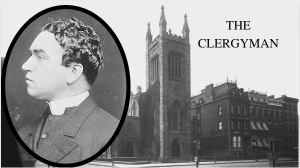
Percy Stickney Grant. (1860-1927.)
Director of St. Marks Mission, Fall River, Massachusetts, 1886-1893; rector of Church of the Ascension, New York, New York, 1893-1924.
Grant received his bachelor’s and master’s degrees from Harvard University and continued with pastoral training at the neighboring Episcopal Theological School. His character can be seen reflected in his works Ad Matrem (1905,) The Search of Belisarius (1907,) and Socialism and Christianity (1910.)
THE EDITOR.
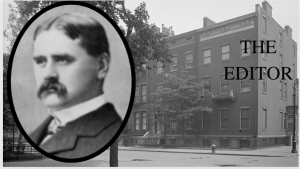
Clement Acton Griscom, Jr. (1868-1918.)
Manager of the Red Star Line, 1888-1901; president of the James Reilly Repair and Supply Company, 1891-1907; manager of the American Division of the International Mercantile Marine, 1901- 1904; editor of The Theosophical Quarterly, 1903-1918; president of the Griscom- Spencer Company, 1907-1911; co-founder of the Open Door Mission, 1913; president of Griscom-Russell Company, 1913-1919.
Griscom was among the “Philadelphia Aristocracy” of the turn of the century. The son of C.A. Griscom, Sr., and Frances Canby Biddle Griscom, his maternal and paternal lines played important roles in Pennsylvania history for over two centuries; “the flag maker,” Betsy Ross, was among his notable ancestors. A Hicksite Quaker by birth, Griscom received his early education at the Friends’ School on Fifteenth & Race Street in Philadelphia. A graduate of the University of Pennsylvania, Griscom, like his father, entered the business world immediately upon graduation. While still attending university, Griscom joined the Theosophical Society, but wary of unwanted attention being directed at his father, who carried the same name, Griscom did not actively promote his association with the organization in public. Griscom was directly involved with many corporate operations over the years, and during the period of Talks, he entered a business deal with fellow Theosophist, Alexander H. Spencer, which saw the James Reilly Repair and Supply Co. reorganized as The Griscom-Spencer Company.
In November 1902, the Griscoms bought a home at 21 Washington Square North and joined Grant’s nearby Church of the Ascension. This coincided with a time period during which a concerted effort was made to rejuvenate the external efforts of the GTS. To that end, in 1903 Griscom financed, edited, and published the journal, The Theosophical Quarterly, as the literary organ of the GTS, which resembled in character and format The Hibbert Journal.
THE BIOLOGIST.
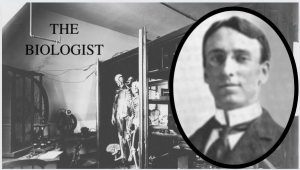
Gary Nathan Calkins. (1869-1943.)
Professor at the Massachusetts Institute of Technology, 1890-1906; professor at Columbia University, 1906-1939.
Calkins was a pioneer in the study of single-cell life forms, who defined several new species, and made extensive contributions to the taxonomy of amoebae and ciliates. His work, The Protozoa (1901,) was the first English-language book published on the subject. As a biologist at the New York State Cancer Laboratory, Calkins investigated the possible role unicellular life played in the development of cancer cells.
THE SOCIAL PHILOSOPHER.
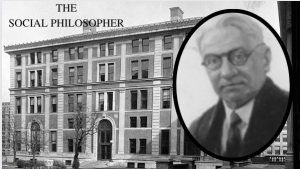
William Pepperell Montague (1873-1953.)
Professor of philosophy at the University of California Berkeley, 1899-1903; Professor at Columbia University, 1903-1947.
Montague was a philosopher full of idiosyncrasies who “hated only meanness, dishonesty, injustice, and cruelty.” The appellation of “Social Philosopher,” which Mitchell uses, is a euphemistic placeholder for Montague’s brand of Socialism. From October 1906, until it burned down in March 1907, Montague and his family lived at the Helicon Home Colony, Upton Sinclair’s experimental Socialist community in New Jersey. In his autobiography, Sinclair writes:
Montague came to us innocent of social theories and even knowledge. But presently he found himself backed up against our four-sided fireplace, assailed by ferocious bands of socialists, anarchists, syndicalists, and single taxers. We could not discover that we made any dent in his armor; but presently came rumors that in the Faculty Club of Columbia, where he ate his lunch, he was being denounced as a “red” and finding himself backed up against the wall by ferocious bands of Republicans, Democrats, and Goo-goos (members of the Good Government League. Of course the palest pink in Helicon Hall would have seemed flaming red in Columbia…In the evenings there were visitors, interesting persons from many parts of the world. John Dewey came occasionally, as the guest of Montague…Another guest was William James who was perhaps the greatest of American psychologists.
THE BANKER.
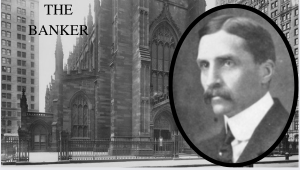
John Fulton Berrien Mitchell (1878-1956.)
Lieutenant in the United States Army, 1898-1901; banker at Redmond Kerr & Co, 1902 (made partner in 1909); Director of Griscom-Russell Company, 1919. Partner in Wood, Low & Co., 1926; Director of the Investors Management Company, 1954.
Brother of Henry Bedinger Mitchell, and an alumnus of Columbia University. After graduating from Columbia University in 1898, J.F.B. Mitchell enlisted in the army and served in the Philippines during the Spanish-American War. After leaving the military in 1901 J.F.B. Mitchell joined the banking firm of Redmond, Kerr & Co. in 1902. Shortly before his death in 1956, J.F.B. Mitchell met with religious scholar Kenneth Morgan to enlist his aid in acting as a liaison between Harvard University and the GTS for a project that would ultimately result in the Harvard University’s Center for the Study of World Religions.
THE PRAGMATIST.
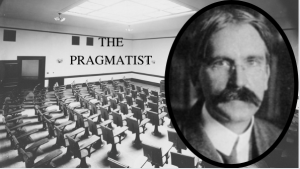
John Dewey (1859-1952.)
Professor at the University of Michigan, 1884- 1894. President of the American Psychological Association, 1899; professor at the University of Chicago, 1894-1904; president of the American Philosophical Association, 1905; professor at Columbia University, 1904-1930.
Following the publication of Studies in Logical Theory (1904,) Dewey accepted a faculty position at Columbia University. During the course of many discussions with his colleagues, F.J.E. Woodbridge and William Pepperell Montague, Dewey was presented with a challenge to fine-tune his theory of instrumental logic, and his conception of experience. Woodbridge, in particular, would deeply influence Dewey’s thoughts on Metaphysics. His thoughts during these Talks are a preamble to his influential essay “Religion and Our Schools.”
THE ANTHROPOLOGIST.
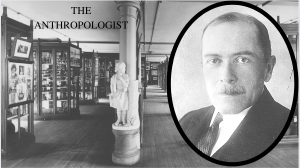
Livingston Farrand. (1867-1939.)
Adjunct Professor of Psychology at Columbia, 1893-1903; professor of Anthropology at Columbia, 1903-1914; executive secretary of the National Association for the Study and Prevention of Tuberculosis, 1905-1914; president of the University of Colorado, 1914-1919; president of Cornell University, 1921-1937.
While an adjunct professor of psychology at Columbia University, Farrand accompanied Franz Boas on the Jesup North Pacific Expedition (1897-1902,) where he documented the traditions of the Alsea, Salish, Chilcotin, Quinault, and others. When Farrand returned to Columbia, he switched departments, becoming a full professor of anthropology in 1903. In 1904 Farrand published, Basis of American History: 1500-1900.
THE OXONIAN.
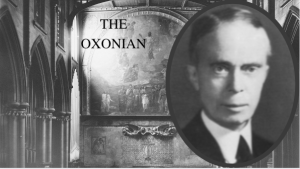
Dickinson Sergeant Miller. (1868-1963.)
Deacon in Episcopal Church; associate professor of philosophy at Bryn Mawr, 1894; instructor of philosophy at Harvard, 1899-1904; professor of philosophy at Columbia University, 1904-1919; professor of Christian apologetics at the General Theological Seminary, 1911-1924; professor of philosophy at Smith College, 1924-1926.
In 1890 Miller began his master’s at Harvard University where he studied under Josiah Royce, George Santayana, and William James, with whom he developed a close friendship. Known for his works on “metaphysics” and “philosophy of the mind,” Miller received his Ph.D. from the University of Halle in 1893. His career at Columbia University began in 1904 as a lecturer, in 1907, at the same time “The Oxonian” makes an appearance Talks, Miller was promoted to professorship, and assigned a seat in the faculty.
THE LOGICIAN.
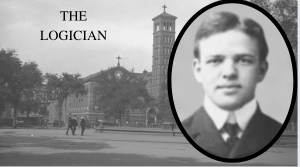
Harold Chapman Brown (1879-1943.)
Instructor in philosophy at Columbia from 1905-1913; professor of philosophy at Stanford University from 1913-1943; president of the Pacific Division of the American Philosophical Association in the years 1924-1925, and 1932-1933.
In 1905 Brown received his Ph.D from Harvard University. In 1906 he accepted the positions of Instructor and Assistant in Philosophy at Columbia University, and in February, 1907, a month after the singular appearance of the “Logician” in Talks, Brown was promoted to the position of Tutor.
THE YOUTH.
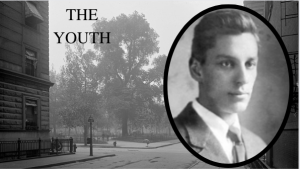
Max Forrester Eastman (1883-1969.)
Assistant in philosophy at Columbia University from 1907-1911; editor of the Socialist magazine, The Masses, from 1912- 1917; co-founder of The Liberator, in 1918.
Max Forrester Eastman was born in 1883, in Canandaigua, New York, also known as the “burned-over” district of New York, so-called for the spiritual fire which enraptured the people in the early nineteenth-century. His place of birth was the womb where the spiritual siblings of Adventism, Mormonism, Shakers, Spiritualism, and the Social Gospel, came to term. His father, Samuel Elijah Eastman, was a Congregationalist minister. So too was his mother, Annis Bertha Ford, who was one of the first women in America to be ordained in a Protestant church. When Max was eleven, Reverend Thomas Beecher, half-brother of Henry Ward Beecher, invited the Eastmans to join him in his Park Church, Elmira, New York, as assistant ministers. Growing up in the church, Eastman writes:
While asking some pity as a boy who lived in a church, I must add that the church formed the center of a fruitfully exciting cluster of people and ideas. They happened to be the same people and ideas that Mark Twain had absorbed into himself by marriage twenty-five years before. His wife’s family, the Langdon’s, lived just across the street from the church, and they were not only the central pillars but the foundation stones upon which it had been built. The portrait of Olivia Clemens’ mother still hangs over the fireplace in the church parlors, and the memory of her father is one with the church’s memory…I met Mark Twain himself in the pews of the Park Church and heard him make a speech from my mother’s pulpit. (Eastman, Enjoyment Of Living. 332.)
Eastman graduated from William College in 1905. From 1907-1911, he studied under John Dewey for a PhD in Philosophy at Columbia University. (Dewey, Woodbridge, Montague, and Robinson were present at his dissertation defense.) When Harold Chapman Brown was promoted in the faculty, Eastman replaced him as assistant in philosophy. Writing of this time, Eastman states:
Dewey was aware that I knew nothing of science; he satisfied himself that I would like to know something about them, and as he said, “There is one kind of coeducation everybody believes in, and that is the co-education of teachers and pupils.” On that theory he lifted me out of my hall bedroom in Greenwich Village and set me down in an office next door to his in the Department of Philosophy and Psychology at Columbia University…In such ways, without costing so much as an intention, education continued to descend upon me. Dewey hired me to study principles of science, and Miller gave me a canoe ride through the history of ideas and paid me to paddle the canoe…Neither Dewey, nor my other superior, F.J.E. Woodbridge, nor anyone at Columbia ever made a suggestion to me as to how or what I should teach. I poured into the moulds of logic all the ideas I believed in or found interesting, from anti-patriotism to the poetic values of obscenity.
CITATIONS.
Morris, Charles. Men of the Century. L.R. Hamersly & Co. Philadelphia, Pennsylvania. (1896.)
“Prominent Long Islanders.” The Times Union. (Brooklyn, New York) July 2, 1897.
Class Book of the Class of ‘95. Columbia College. New York, New York. (1899): 29-30.
Office of the President. Annual Report. Columbia University. New York, New York. (1900.)
Chambers, Robert W. The King In Yellow. Harper & Brothers. New York, New York. (1902.)
American Mathematical Society Annual Register. American Mathematical Society. New York, New York (1903.)
Wharton, Edith. The House Of Mirth. John Lehmann Ltd.London, England. (1905.)
Bond Chapman, Leonard. Monograph on the Southgate Family of Scarborough, Maine: Their Ancestors and Descendants. Hubbard W. Bryant. Portland, Maine. (1907.)
Mitchell, Henry Bedinger. “A Stone of the Foundation.” The Theosophical Quarterly. Vol. XVII, No. 1 (1919.)
“History Professor Quits Columbia.” The New York Times. (New York, New York) May 6, 1919.
Eastman, Max. Enjoyment Of Living. Harper & Brothers. New York, New York (1948)
Hendricks, Luther V. “James Harvey Robinson and the New School for Social Research.” The Journal of Higher Education. Vol. XX. No. 1 (January, 1949.)
Rutkoff, P. M., & Scott, W. B. New School. Simon and Schuster. New York, New York. (1986.)
“Bachelors As Artists In Residence.” The New York Times. (New York, New York) April 27, 1997.
Harris, Luther S. Around Washington Square: An Illustrated History of Greenwich Village. Johns Hopkins University Press. Baltimore, Maryland. (2012.)
Mitchell, Mary Bedinger. “A Woman’s Recollections of Antietam.” In The Civil War: The Second Year Told by Those Who Lived It. Sears, Stephen W. (editor) Library of America. New York, New York. (2012.)
Higgins, Shawn F. “The Benedick: An Analysis of Talks on Religion.” Dewey Studies. Vol. VI, No. 2. (2022): 16-75.


